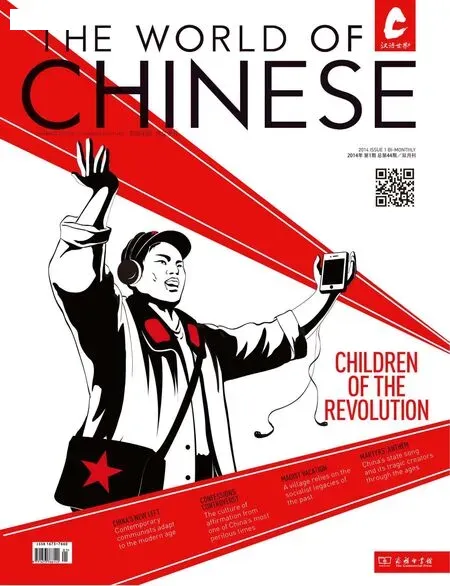HIP TO BE SQUARE
2014-03-01TEXTBYCHRISHAWkE
TEXT BY CHRIS HAWkE
HIP TO BE SQUARE
TEXT BY CHRIS HAWkE
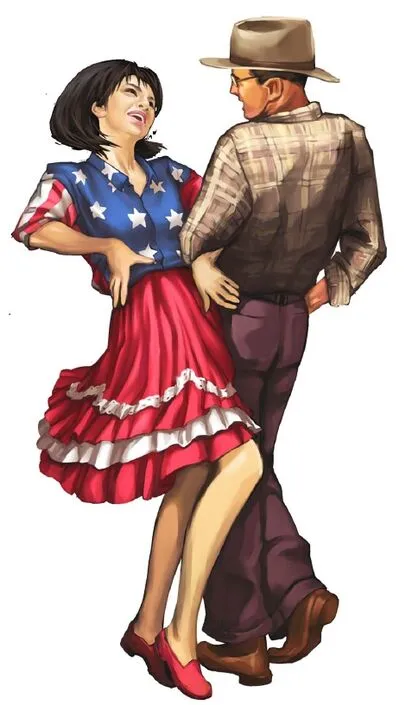
Spreading American square dancing throughout China
教中国人跳四方舞“四方舞”
I came to China to work as a professional journalist. But I got more mileage out of playing square dance music over the last month than from six years of slaving over a keyboard—both professionally and literally. In November, our band performed hillbilly music in 19 venues over 23 days, going from Beijing to Shanghai, Suzhou, back to Shanghai, Dali, Hangzhou, Xi'an, back to Beijing, Xinxiang in Henan, and back to Beijing again. The money wasn't bad either, at least compared to journalism, and in some places we were treated as stars. But that's China for you, always surreal. When opportunities are thrown at you, it's best to just go with the fl ow.
Square dancing is a bit archaic, a bit provincial, and an altogether strange thing to be associated with China. Regardless, square dance thrives in certain circles today andseems tailor-made for a country that values group dynamics over individualism. Square dancing in China arose thanks to a Texan (whose name no one seems to remember) who taught a few retired people modern Western square dancing 20 years ago. Unlike traditional southern square dancing, modern square dancing is often done to pre-recorded music. It is competitive and has an elaborate grading system.
The most striking thing about these dancers is their outfits: imported frilly dresses that might be at home in a Western saloon, a figure skating competition, or onstage at the Moulin Rouge. Better yet, to address the gender imbalance, a number of the women dress in fl annel and trousers, occasionally sporting shiny belt buckles.
At about the time this old time music started to make a comeback, a young man called Michael Ismerio became involved. He lives in a cabin in the woods, making shoes and music for a living. He is also a square dance caller. If there is such a thing as a famous square dance caller, then Ismerio would be it. When Ismerio fi rst came to Beijing a few years back, it was to perform for an American businessman who had fl own him over. Yes, some people in the world fl y a square dance caller over for a party.
My grandpa loved hillbilly music and owned a mandolin, fi ddle, autoharp, guitar, and banjo. Other thanDeliveranceand Bugs Bunny inHillbilly Hare, I knew little about the music until I stumbled upon a group of musicians playing it in Beijing each week. It was at this weekly meeting of the Beijing Pickers that I met my future band mate, Kirk Kenney. Kenney didn't really know what old-time music was until two and a half years ago when Ismerio met all the local pickers. Kenney, who saw him perform and was mesmerized, immediately switched from guitar to fi ddle. That's the spell this music can put on some people.
One night Kenney told me that Ismerio was coming back to China, and we wanted to make his arrival a big deal for all the square dancers of Beijing and for the rest of China as well. So, with considerable help from a State Department-backed cultural exchange foundation called Ping Pong Arts, Kenney and I arranged a 23-day tour for Ismerio throughout China with our band, The Hutong Yellow Weasels, serving as Ismerio's backup on upright bass and guitar. And this is how our crazy tour came about, each of us blindly assuming that people would love it because we think square dance music is intrinsically excellent with universal appeal. On the road in China, we found out this is not exactly true.
A popular pastime in some Chinese bars is playing a game of dice that requires a lot of bluff i ng and little skill. The game allows you to interact and learn about the people you are with—their intelligence, conf i dence, and ability to have fun—all without having to speak to each other or fi nd common ground for conversation. In many ways, square dancing is the same but with the added bonus of being able to meet and touch many attractive strangers, in the most innocent way possible of course. Very few who try square dancing ever regret it, and for many, it is a highlight of the week.
But for some reason, once we started our tour, we found Chinese dice players did not take to our brand of hillbilly music. Before getting on stage for the fi rst gig of the tour in Beijing, we admittedly hadn't really practiced together. On the fi rst night Ismerio arrived in Beijing, we shuff l ed him straight into the studio to help us record a CD to sell on tour; jetlagged, he fell asleep during practice.
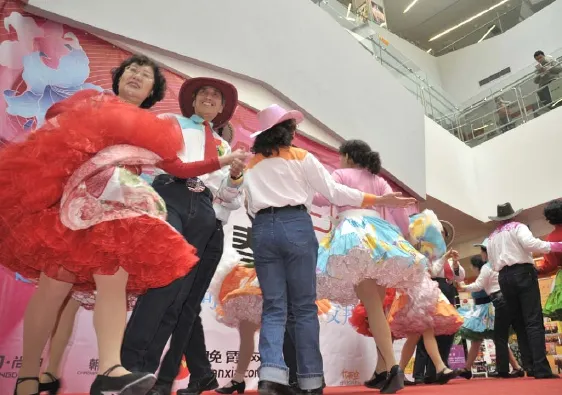
Square dancing has a cult following in many Chinese circles
On his second night, Ismerio played host to a jam session at a local bar, and on the third night we earned some money playing a gig at an Irish bar. We had planned to practice on the high speed train down to Shanghai onthe next day but instead spent the time burning our new CD on Kenney's laptop and discussing logistics and tour fi nances. At our first gig in suburban Shanghai, Ismerio did a solo set, singing a mournful, unaccompanied song about an impoverished bootlegger, the sound of dice rattling in the background. To say his song brought the energy level down from the Black Eyed Peas and Maroon 5 that was on before would be an understatement. Shortly thereafter the half-dozen or so paying customers cleared out. Things did not start well. But up next was a big music festival, and, to my relief, Ismerio avoided songs about bootleggers, and everybody square danced, setting a pattern that followed for almost every gig.
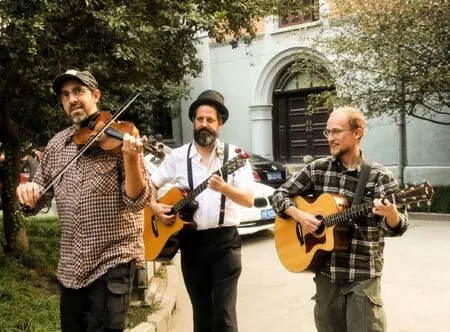
The Hutong Yellow Weasels jam out in the streets of Shanghai
Ismerio was delighted to get out of Beijing—the pollution made him sick and played havoc with his voice. As uncomfortable as it was for him, his illness ended up being a big opportunity for me, as it forced me to learn to call square dances and to sing Ismerio's songs.
During this tour, the tempo was intense. Ismerio did not get to see the Bund, West Lake, the Xi'an old city and its amazing walls, or even the Longmen Grottos. Most of our energy was consumed by the nitty-gritty of getting from one place to another, eating, and trying to rest when we could. We often had to get up at fi ve or six to catch a fl ight, and gigs could go as late as midnight or one in the morning. A music tour can be trying; a lot of the
WE OFTEN HAD TO GET UP AT FIVE OR SIX TO CATCH A FLIGHT, AND GIGS COULD GO AS LATE AS MIDNIGHT OR ONE IN THE MORNINGtime you are fi guratively living in each other's pockets. You become attuned to the personal habits of your band mates. By the end you can practically set your watch by each others' bowel movements. Such movements were myriad: Ismerio had a hard time adapting to the local diet. Almost missing a flight check-in due to Ismerio's bathroom distress—not groupies or parties—was the most adrenaline-f i lled moment of the tour.
In Shanghai, we were introduced to two local musicians who playpingtan(评弹), a highly stylized traditional music that features a Chinese lute, vocals, and a three stringed instrument related to the banjo. When we met at a practice space to jam, we were lost in space. The melody sung by the female lute player used a pentatonic scale, like the ones used in Appalachian music, but we could fi nd no rhyme or reason to the melody. Finding the start of a verse or end of a chorus was impossible.
We changed gears and Ismerio taught the lute player a simple folk melody, repeating a line over and over again so she could catch it. But instead of playing along, she would dive in at seemingly random intervals in the middle of the verse, apparently unaware where the melody started and ended. Two folk traditions met, but their roads did not converge. We later learned, during a drunken banquet with a music professor, why thepingtansinger had thrown us off so. This music is not broken up into measures, verses, and choruses like Western songs. Instead, the singer follows a text, freely elongating certain notes according to her feelings. It has a structure but no rhythmic framework.
The most expensive leg of the tour was a show in remote Dali, Yunnan Province, an ancient city nestled in mountains, famous for its wild hemp plants, bohemian lifestyle, and colorful ethnic minorities.
A few days before a show, I called my contact who said with surprise, “What? I didn't think you were coming.” There had been bad communication on all sides, and the show had not been promoted. With such short notice, it was doubtful anybody would come. We tried to cancel our expensive plane tickets, but it was too late.
We called the owner of the venue we were supposed to play and told her we would promote the show by playing on the street and handing out fl yers. Tickets were a hefty 80 RMB each, so we stood to make good money if a lot of people showed up. We needed to make 5,000 RMB each to cover expenses. I called the owner of a backpacker bar who had offered to give us a place to stay, free food and 200 RMB each if we did a show. Desperate, we accepted on
TWO FOLk TRADITIONS MET, BUT THEIR ROADS DID NOT CONVERGEone condition: the show would have to be“secret” and unpromoted, so it would not cut into our ticket sales at the venue down the street. “A secret show! We can do that mate,” said the owner of the Bad Monkey Bar in Dali.
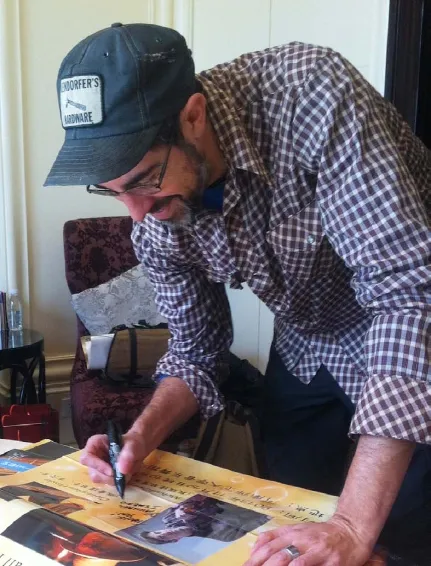
Legendary square dance caller Michael Ismerio autographs posters at a Chinese gig
That fi rst night, we sold 600 RMB worth of CDs. The secret of selling CDs in China is to sit down and chat with people, ask where they are from, and pose in a couple of photos with them. One group of stylishly dressed young men, their table loaded with beer and fruit plates, bought fi ve discs. This was the fi rst of many full sets of CDs we sold.
The next day we set up in front of the Café September, where we were supposed to be gigging that night and sold another 600 RMB of CDs by busking on the street. The owner of the café suggested we delay the gig a day, so Bad Monkey took us onboard a second night. We again sold a bunch of CDs, making 1,800 that day. We cleaned up busking the next day too, and to our surprise, the café was full of cultured, attentive young Chinese professionals; it was our best show of the entire tour. Ismerio was on fire, and it ended with everybody joyously square dancing on the street outside the café because it was too crowded inside. They even loved his mournful solo about a coal mining disaster. The gig we were about to cancel turned out to be the best of the tour, and we left Dali with a small prof i t. In truth Dali was also the only truly beautiful place we encountered on our tour. We climbed a man-made path up the cloud pass near the city. And, although there was not much in the way of wild animals living there, the sky was blue and clouds were clearly visible in the sky—something not available everywhere else we traveled.
We exchanged messages with the elderly Chinese square dancers that Ismerio led in a few square dances in Beijing when we arrived. Although they smiled throughout, for some reason, their representative was not impressed. “The dances are too easy,”he said, adding that no one wanted to pay for tickets. With that, we canceled our plans to meet with our Beijing square dancing comrades and moved on.
THE GIG WE WERE ABOUT TO CANCEL TURNED OUT TO BE THE BEST OF THE TOUR
At a later gig at a university in Xinxiang, Henan Province, we were greeted by twostudents holding a sign with our names. The city of Xinxiang (新乡) means New York, they explained, and the dozens of half completed luxury high rises dotting the downtown belied the dusty city's new wealth. Our hotel rooms were as luxurious as a presidential suite. At the university, red banners welcomed us by name. On the walls were posters with giant images of our faces. The digital clock in the center of campus welcomed us by name. It seemed that, in Henan, we were going to be a big deal.
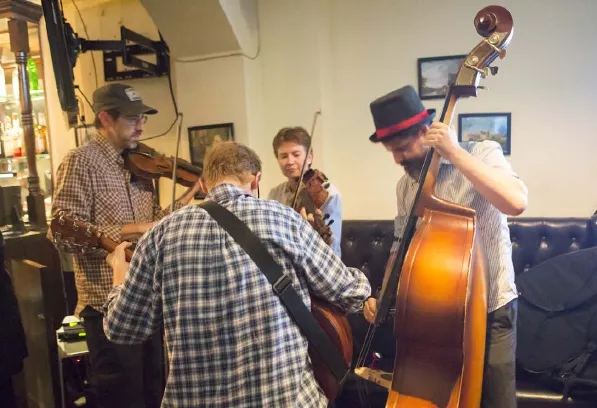
The Hutong Yellow Weasels fine-tune their instruments shortly before a performance
The leaders of the school, of course, cracked-open their bestbaijiu. In Beijing, there is a government crackdown on feasting, dubbed “four dishes and a soup”. Word, however, apparently had not spread to Henan. We ate in dining rooms that would do Donald Trump proud and feasted heartily every lunch and dinner. The largesse of the university off i cials seemed boundless, with Kenney and Ismerio drinking until they could barely walk.
During our concert, giant images of our faces were projected on the screen behind us. In Xinxiang, we were stars. Girls and boys gathered around to get their pictures taken with us after the show, and we spent 10 to 15 minutes signing CDs.
This was a stark contrast to the all-together less glamorous Hangzhou, where we were informed we would need to share rooms. During our gig at the Reggae Bar, dice rattled continuously and people paid little attention. As I tried tolead a square dance, a drunken Chinese man came up to me and told me my dance partner was married.

A couple of Beijing ladies give each other a twirl, square dance-style
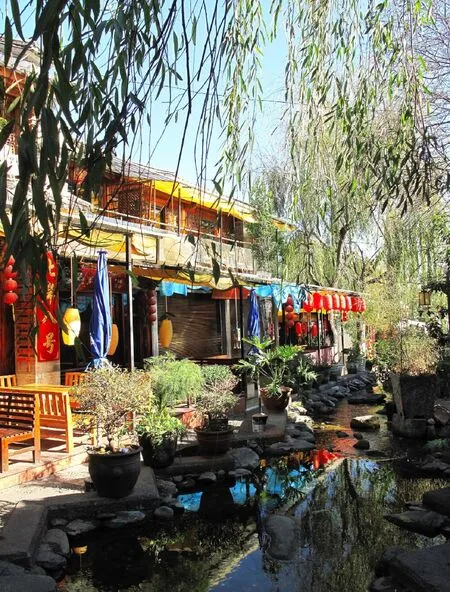
The Hutong Yellow Weasels found themselves square dancing in the natural beauty of Dali
“It doesn't matter, I have a girlfriend already,” I said. He tried to pull her off the fl oor; I waited for the bouncers or management to step in, but they didn't. So, the dice kept rattling. My band mates persuaded me to call another dance. I did, but I hated every last second and will never play at a venue with dice again.
After the Hangzhou bust, I reached out, once again, to the senior square dancers from Beijing. After extensive negotiations, they agreed to come to a special show for them at a venue called Mako Live House, opening for a larger gig involving most of the active old-time and bluegrass musicians in town.
We negotiated for Ismerio to teach them about the roots of square dancing and emphasize its role in making friends and socializing, presumably to offset the fact that his dances were at too low a level of difficulty for these particular Chinese masters. He taught them the Virginia Reel and other dances, and everyone had a good time; although the elderly dancers got in a dispute with the management over food orders and how the ticket receipts should be divided, in the end leaving us with only a few hundred RMB for our efforts.
Eight of the costumed dancers stayed for the big show that evening. Ismerio came on after the Randy Abel Stable. With a smile, he said, “Watch this,” and jumped into his slow, mournful unaccompanied song about moonshining, which flopped at our first gig. The crowd loved it. He planned to perform a few songs to lead into square dance, but the elderly dancers jumped to their feet and started doing the Virginia Reel on their own and without a caller. Suddenly, the young Chinese and Westerners in the audience joined in, the formation of dancers getting bigger and bigger. Old people were dancing with youngsters. Westerners were dancing with Chinese. The music went on for over 20 minutes, all without the help of a caller. It was an emotional moment—the square dance we loved so much spreading of its own volition across all boundaries. After the tour, I told Ismerio that I worked really hard to make the tour happen, but that most of the good luck came from others stepping in at the last minute. He responded,“I've spent thousands of hours studying the fi ddle, and after shows, people come up to me and say, ‘Michael you are a great—no—good fi ddler.' But I've spend hundreds of hours calling square dances, and people say, ‘You are the best square dance caller ever! I had so much fun.' I've learned to let things just come to you.” I'd like to take some credit for spreading the joy of square dancing and Appalachian music across the breadth this country, but the music and the joy, pain, faith, and sense of community it embodies travelled a long way before I got on the scene, and it will live on long after I'm gone, with or without my efforts. In the meantime, I'm plotting my return to Dali.
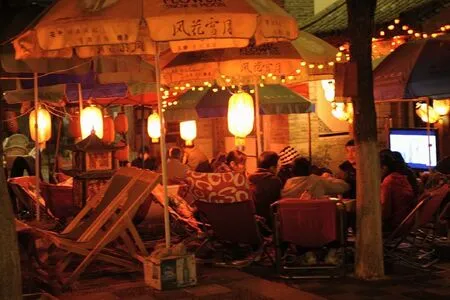
The days in Dali are full of blue, cloudless skies, but the nights hosted some of the Hutong Yellow Weasels' best gigs
